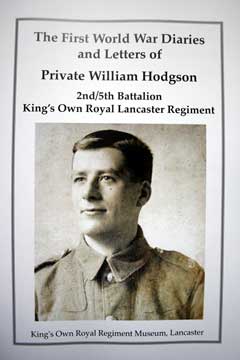HOME
Museum &
Collections
Sales
Donations
Events
Contact Us
REGIMENTAL HISTORY
17th Century
18th Century
19th Century
20th Century
First World War
Second World War
Actions & Movements
Battle Honours
FAMILY HISTORY
Resources
Further Reading
PHOTO GALLERY
ENQUIRIES
FURTHER READING
LINKS


|
First World War
2nd/5th Battalion,
King’s Own Royal Lancaster Regiment
|
7 February
1917 |
Arrived in
France at Le Havre |
|
February 1917 |
Joined 170th Infantry Brigade of the 57th Division |
|
July to October 1917 |
Third Battle of Ypres |
|
October 1917 |
3rd Battle
of Ypres: Battle of Poelcappelle |
|
26 October 1917 |
Attack on Shaap-Balie |
|
December
1917 |
Houlthoust
Wood |
| |
Attack on
Hindenburg Line |
|
25 August
1918 |
Battle of
the Scarpe: Hendicourt, Cagnicourt |
|
29 August
1918 |
Battle of
the Scarpe: Riencourt |
|
September 1918 |
Advance near Marcoinge |
|
27 September
1918 |
Battle of
Canal du Nord |
|
8 October
1918 |
Battle of
Cambrai
Capture of Riencourt |
|
8 October 1918 |
Attack near Paris Copse |
|
May 1919 |
Returned to United Kingdom |
2nd/5th Battalion, The King’s Own
Royal Lancaster Regiment
This unit started its life in Lancaster on the 15th August
1914, and was then known as the 5th Reserve Battalion.
The Mother Battalion having undertaken the Foreign service obligations
it was thought desirable to form a reserve unit, for the dual purpose of
supplying drafts to the 5th Battalion and to take its place as a Home
Defence Unit.
This duty was given to Captain F W Seward who was left behind as Officer
Commanding Depot of the 5th Battalion.
Recruiting started in earnest and no fewer than 82 men joined in one day
from the same firm. When the 5th Battalion made their first call for men
at the beginning of September 1914 it received a draft of 200 of the
fines recruits that ever paraded. They enabled the 5th Battalion to weed
out all their unfit men.
The main recruiting areas were Lancaster, Morecambe, Fleetwood and the
surrounding districts.
In spite of the strenuous life which was made up of 9 hours drill per
day and 3 hours fatigue duty every other day, the Battalion grew and it
speaks well for the keenest of men when it is realised that the New
Battalion was some 600 strong before an extra officer was posted to it
in the person of Major Keen. In these early days the work was hard.
Starting at 6 a.m. with Physical Training on the green in front of the
Castle. 8 a.m. – 9 a.m. Breakfast in the Drill Hall, 9.30 a.m. General
Training on the Giant Axe Field on a route march until Dinner at 3. p.m.
Tea 6 p.m. Lights out 10.30 p.m.
Between 3 pm and 7 pm the job of attestation went on, plus recruiting
meetings from 7 p.m. to 10.30 p.m.
Once a week we did as an extra a short night march between 9 p.m. and 11
p.m.
In spite of this work men continued to enrol, and many were cases of
youths who, when told they were too young to enlist, came back next
night one or two years older, but the keenest man the writer knew was an
old regular who after leaving the army joined the volunteers and was for
many years my fathers batman.
This man whose name was Schofield, and incidentally a very good shot
came three times to join each time his age dropped by five years but
even then he was over age. He was a soldier through and through and
finally joined the National Reserves, and after a period of guarding
roads etc. He finished his military career as a guard to German
prisoners.
At the end of October 1915 the Reserve Battalion was given a Commanding
Officer. Lieutenant Colonel W Compton Hall VD and other officers were
appointed.
On 12th November 1914 we left Lancaster to undergo Divisional training
at Blackpool. Arriving in Blackpool we became part of the North
Lancashire Brigade.
Our marching showed our strength as 23 Officers and 840 other ranks.
At Blackpool the troops were all billeted in Boarding Houses and fed in
their billets by the owner. The training was of a preliminary nature and
consisted mainly of company training. Recruits kept adding to our
strength but we were still being called upon for drafts to the 5th
Battalion.
Here the Battalion was formed into separate Companies and trained under
their own officers and it was a great day when uniform and equipment
were issued out to us. Up to this time all the men had been wearing
their own clothes and the first parade of the Battalion after the issue
of uniform, gave us a very much better opinion of ourselves.
Photographs: 2nd/5th (Territorial Force) Battalion, King's Own Royal Lancaster
Regiment
Collections: 2nd/5th (Territorial Force) Battalion,
King's Own Royal Lancaster Regiment
Books: 2nd/5th Battalion in the First World War
A digital version of the Battalion War Diary is available on
cd-rom from the Museum Shop.
|



.jpg)
.jpg)